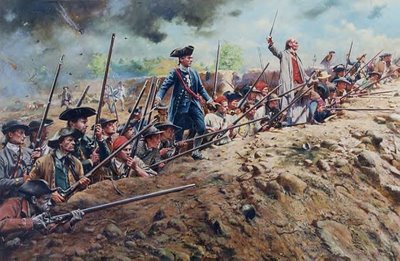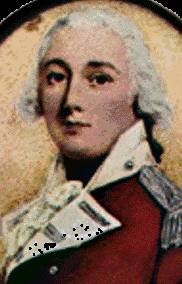An Appreciation of the Battle of Bunker Hill on its Anniversary
by Mike Vanderboegh
17 June 2008
"The day -- perhaps the decisive day -- is come, on which the fate of America depends." -- Abigail Adams
 The
Battle of Bunker Hill by Dan Troiani
The
Battle of Bunker Hill by Dan Troiani"But even when the level of training reached its lowest ebb, late in the 1760s, the militia troops still practiced their marksmanship, and handling of weapons remained important. There developed an easy-going familiarity with weapons, something that can be best described as the Rogers influence: care of the weapon and marksmanship received attention, and sham battles (Rogers' favorite training) took place at every muster....In the fall of 1774 the picnic atmosphere disappeared
from troop exercises and the men began to train in earnest...These men knew they might soon be facing the regulars on the battlefield, and they did not intend to be scoffed at this time. Would there be time enough to form the militia and minute men under new officers and prepare them to stand against the regulars? Luckily the provincials were not starting from scratch. They possessed two important assets which were to be of immeasurable help in the coming months: the minute man
concept, which was well understood by all the soldiers, and.....a heavy distribution of combat veterans from the French and Indian War." -- General John Galvin, "THE MINUTEMEN", 1989, Pergamon-Brassey
"COLONEL PRESCOTT WILL FIGHT YOU TO THE GATES OF HELL."
Today, 17 June, is the anniversary of the Battle of Bunker Hill, which in the odd way of historical memory, was actually fought on Breed's Hill outside British occupied Boston in 1775. Following Lexington and Concord on 19 April 1775, the British, having been given a bloody nose by the Massachussett's militias, withdrew into Boston. Soon, the Redcoats were surrounded by tens of thousands of American militia from several states, but few American officers wanted to test the British defenses by direct assault.
But if they couldn't carry out a general attack against the dug-in British (who were supported by naval gunfire from ships in the harbor), they could tighten the noose around the Regulars. Thus, on the night of 16-17 June, Colonel William Prescott led 1500 men onto the peninsula overlooking the city. After a disagreement between militia commander Israel Putnam, Prescott and their engineering officer, Captain Richard Gridley, Breed's Hill was decided to be more defensible than Bunker Hill.
There, using Gridley's plan, they built a fortification 160 feet by 80 feet with ditches and earthen walls. They reinforced a fence running away from the redoubt down to their left and added ditch and dike extensions toward the Charles River to their right. With the dawn, British ships began firing upon the works but were unable to elevate their guns high enough to hit.
Across the river channel in Boston, General Gage and his staff stood talking with loyalist Abijah Willard, who was Prescott's brother-in-law. Looking through a telescope, Willard recognized his Prescott. "Will he fight?' asked Gage. "As to his men, I cannot answer for them;" replied Willard "but Colonel Prescott will fight you to the gates of hell."
It took almost six hours for Gates to gather his infantry and get them poised to strike. General Howe was to lead the major assault, drive around the Colonist's left flank, and take them from the rear. Brigadier General Pigot on the British left flank would lead the direct assault on the redoubt. Major John Pitcairn, of Lexington green fame, the flank or reserve force. It took several trips in longboats to transport "the lobsters" to the eastern corner of the peninsula at Moulton's Hill. It was a warm day, and with wool tunics and 60 pound field packs the British were finally ready by about 2 p.m.
"HEY,DIDDLE DIDDLE, RIGHT UP THE MIDDLE."
The Colonists also reinforced their numbers and position. There were perhaps 2600 British Regulars and 1500 American militia about to slug it out toe to toe. But the Brits were going have to come and dig the militia out from behind their fortifications. In retrospect, the British should have used their control of the harbor to deposit troops behind the Americans and bag the lot. In retrospect, the Americans should have prepositioned more powder and shot with the forward troops. The Americans, after all, had little artillery and this was to be a fight of rifles, muskets, and at the end, bayonets for those who had them. But hindsight, as they say, is twenty-twenty. Fortunately for the Americans, however, British General Howe rejected all of his other tactical possibilities and came at them "hey diddle, diddle, right up the middle." It was a slaughter.
The first assaults on the fence line and the redoubt were met with massed fire at close range and repulsed with heavy British losses. The reserve, just north of the town, was also taking casualties from rifle fire in the town. Howe's men reformed on the field and made a second unsuccessful attack at the wall. They were again thrown back with heavy losses.
By this time, the Colonists had lost all fire discipline. In traditional battles of the eighteenth century, companies of men fired, reloaded, and moved on specific orders, as they had been trained. After their initial volley, the Colonists fought as individuals, each man firing as quickly as he could. The British withdrew almost to their original positions on the peninsula to regroup. The navy, along with artillery from Copp's Hill on the Boston peninsula, fired heated shot into Charlestown. All 400 or so buildings and the docks were completely burned, but the snipers withdrew safely. In the third British assault the reserves were included and both flanks concentrated on the redoubt. This attack was successful. The defenders had run out of ammunition, reducing the battle to close combat. The British had the advantage here as their troops were equipped with bayonets on their muskets but most of the Colonists did not have them. The British advance, and the Colonists' withdrawal, swept through the entire peninsula, including Bunker Hill as well as Breed's Hill. However, under Putnam, the Colonists were quickly in new positions on the mainland. Coupled with the exhaustion of Howe's troops, there was little chance of advancing on Cambridge and breaking the siege." -- Wikipedia, "The Battle of Bunker Hill."
Gage's troops had swept the field, but at what cost! Over a thousand had been shot, with 226 immediately dead and 828 wounded. A disproportionate number of these were officers, all of Howe's staff save the general himself were down or dead. The militia lost 140 dead, 280 wounded and 30 prisoners (only 10 of whom survived imprisonment).
"'Twas a famous victory," the poet had said. The surviving British officers did not think so about Breed's Hill. Wrote a mortally wounded Colonel Abercrombie from his deathbed to Lord Loudon, "A few such 'victories' would Ruin the Army."
PITCAIRN AND SALEM
Of the British dead, one was mourned by some on both sides. Major Pitcairn, the Scottish Royal Marine who was respected by the citizens of Boston as one of the more reasonable members of the occupying force, was shot down by Peter Salem, a freed slave who served in Captain Drury's company of Colonel John Nixon's 6th Massachusetts Regiment.

Major John Pitcairn, killed at Bunker Hill by Peter Salem
A veteran of Lexington and Concord, Salem fought again at the battles of Saratoga and Stony Point and died in the poorhouse of Framingham, Massachusetts at the age of 68 in 1816. A gravestone monument was erected in his memory in Framingham in 1882. Pitcairn's body never made it home, and is buried in Boston like so many of his fellow British soldiers and Marines from that bloody day.
MYTHOLOGY
"As time went by we built the mythology of the Minute Men even further. We depicted them as a small but courageous band of farmers who responded to a spontaneous call to arms, an untrained and poorly armed rabble. The truth, of course was very different. There were actually 14,000
colonials under arms in the militia and Minute Man regiments. They were alerted by organized alarm riders via a system that dated back to the 17th century wars. They had trained intensively for a year and were armed with the same type weapons as the British. Lexington was an important battle in the history of the United States, not only because it was the opening moment of the war that created our country but also because it provides us a microcosm of the drift to war-- with all the
tensions, the misinterpretations, the fears and the posturings, the courageous and the foolish acts that augur the clash of arms." -- Galvin, Ibid.
Press.
"They had trained intensively . . ." Peter Salem did not hit Major Pitcairn by happy accident. He hit him because he was a practiced rifleman. Keep that in mind for future application. The colonists were certainly undisciplined as militia are wont to be. Some used the excuse of carrying wounded to drift away from the battle entirely. Somebody forgot to bring up the ammunition in time. Some sat within easy supporting distance of the fight on Breed's Hill, and did not move forward into the fight at a critical moment. But the significance of the fact that the American militia had faced the Regulars and, for a time prevailed, was not lost on either side.
"Something else, something entirely intangible and perhaps not even recognizable at the time, had occurred on June 17, 1775. Men who were not fighters by trade or inclination had stood side by side behind their earthworks and their fences and had waited calmly while some of the most formidable fighters in the world advanced against them in ordered ranks. They had not run from artillery fire, they had stood up to the wild terror of a bayonet charge, and they had broken only when their ammunition gave out and they could fight no more. A few months earlier the odds against the success of any American military effort would have been overwhelming; the regular army was an object of dread, not to be tested. Now Americans had met it face to face, and like a
figment of darkness suddenly exposed to the light, it could be seen for what it was-- an army that commanded great respect, but one composed of men no taller or stronger than any others. By demonstrating that some ordinary American farmers had stood against this formidable enemy, the
battle of June 17 proved, as nothing else could, that others might accomplish the same thing. Had they failed, it is just conceivable that the rebellion might have sputtered out." -- Richard M. Ketchum, DECISIVE DAY: The Battle for Bunker Hill, 1962, Anchor Books.
Training. Training and preparation made the difference. And I told you all of that to ask you this: What have you, a member of the armed citizenry of the United States, done lately to honor these men's sacrifices? What training have you done to maintain and build the skills required of a member of the unorganized militia of this Republic? You haven't? If you are not organized, if you are not trained, if you have not maintained the skill of a rifleman, then the only "mythology" you need worry about is the one inside your head. Peter Salem would tell you to pull your head out of your arse and get busy. Tyrants are not deterred by untrained braggarts.
-- Mike Vanderboegh
PO Box 926
Pinson, AL 35126
[email protected]
